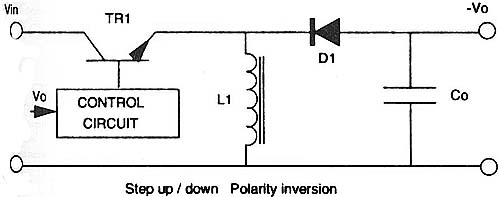AMAZON multi-meters discounts AMAZON oscilloscope discounts
A combination of the buck regulator and boost regulator is shown in Fig. 1. This combination circuit is called the buck-boost regulator and it utilizes the strong points of both of the previous regulators. From the schematic note that the transistor is connected in series like the buck converter and the inductor has been moved to a position where it's connected in parallel with the output terminals. The freewheeling diode is connected as it was in the boost regulator.
The transistor controls the voltage to the output in this circuit. When it's turned on, the inductor will store energy. When the transistor is turned off, the stored energy will be large enough to forward bias the diode and pass voltage to the output terminals. Since this circuit has the basic operation of both the buck and boost regulators, it means that the output voltage can be regulated both above and below the input-voltage level. For this reason the buck-boost regulator is more popular. The waveforms for this type of circuit are similar to the boost regulator.

Above: Fig. 1: Schematic of a buck-boost regulator.